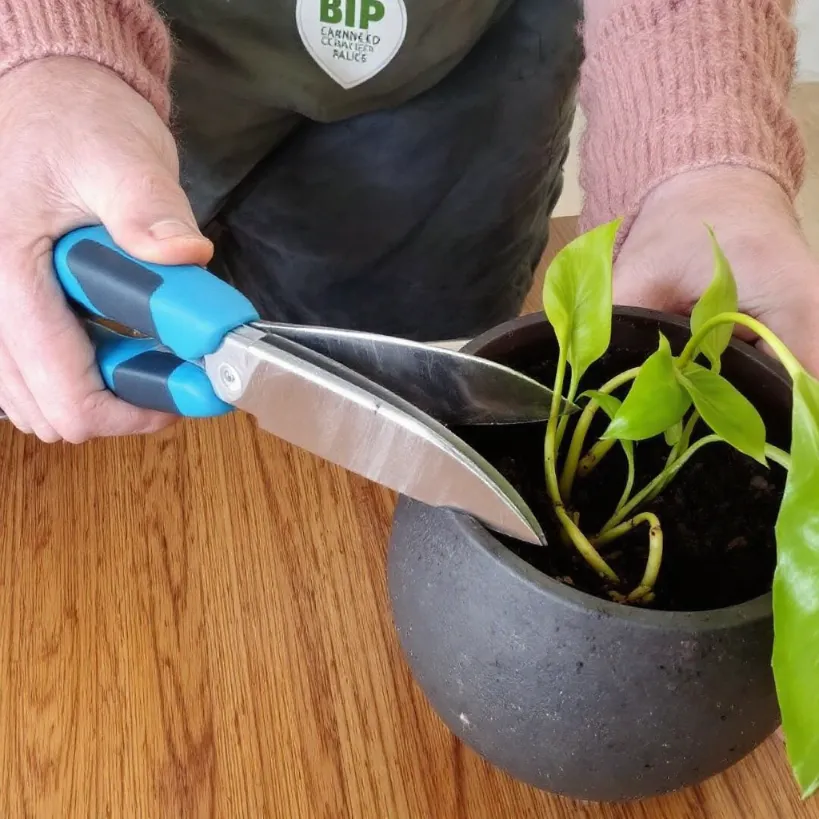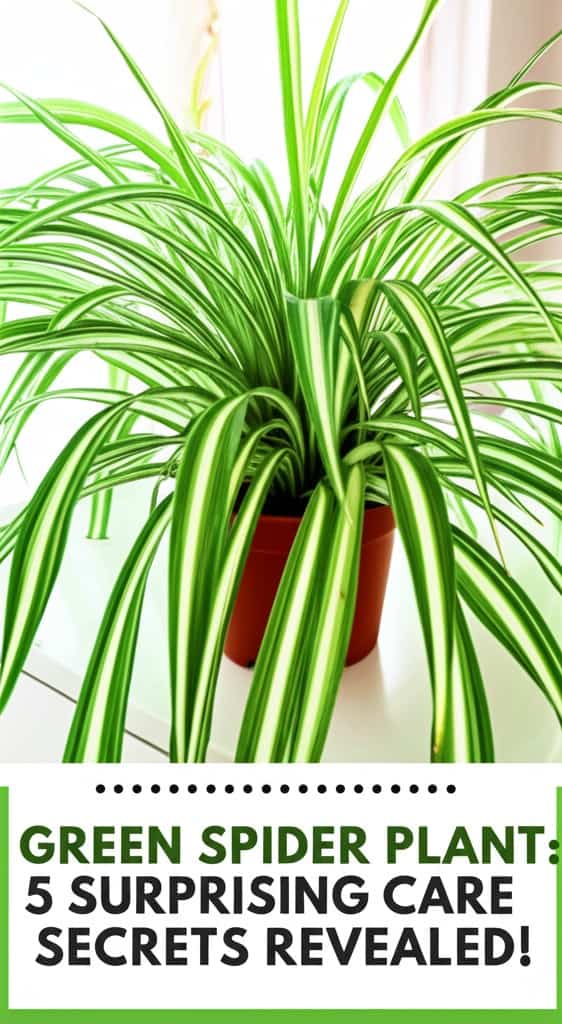Spider plants need pruning when their leaves turn brown or yellow—and you’ll want sharp scissors for this job.
Cut damaged leaves at the base, trim off baby plants (spiderettes), and remove any dead foliage to keep your Chlorophytum comosum healthy and looking its best.
Key Takeaways
- Best pruning time: Spring and summer during active growth for faster healing
- Essential tools: Clean, sharp scissors or pruning shears prevent damage and disease
- What to remove: Brown leaves, yellow leaves, dead foliage, and excess spiderettes
- Pruning technique: Always cut at the base of leaves, working from center outward
- Growth benefits: Redirects energy to healthy foliage and encourages new growth
- Propagation bonus: Removed spiderettes can become new plants
Why Your Spider Plant Needs a Haircut

Your spider plant sits there, looking a bit rough around the edges. Maybe some leaves turned brown. Perhaps the whole thing looks wild and untamed. That’s when you know—time for a trim.
Spider plants grow fast. Really fast. They shoot out leaves in every direction, produce baby plants on long stems, and sometimes get too big for their own good. Without regular pruning, they become messy and stressed.
The good news? Trimming spider plants doesn’t require rocket science. Just some basic know-how and the right approach.
When to Break Out the Scissors
Spring and summer—that’s your golden window. Spider plants grow most during these warm months, so they heal faster after pruning. Cut them in winter, and they’ll sulk for weeks.
Watch for these signs that scream “prune me”:
- Brown leaf tips spreading down the blade
- Yellow leaves taking over
- Too many baby plants weighing down the mother plant
- Leaves bending or breaking under their own weight
- The whole plant looking scraggly and unkempt
Tools You Actually Need

Forget fancy equipment. You need:
Sharp scissors – Dull scissors crush stems and invite disease. Clean them with rubbing alcohol first.
A container – For collecting trimmed leaves and spiderettes.
Water – If you plan to propagate those baby plants.
That’s it. No special pruning shears required unless you prefer them.
The Right Way to Prune Your Spider Plant
Start at the center and work outward. This method keeps the plant’s natural shape intact.
Step 1: Remove the obvious problems
Cut out completely brown or yellow leaves first. Slice them off right at the base where they connect to the plant. Don’t leave stumps—they look ugly and can rot.
Step 2: Trim damaged leaf tips
Got leaves with just brown tips? Cut the tip at an angle to mimic the natural leaf shape. This keeps things looking normal instead of blunt and weird.
Step 3: Deal with the babies
Those cute spiderettes hanging everywhere? They drain energy from the mother plant. Cut the runners (stolons) close to the main plant. Keep the healthiest babies for propagation.
Step 4: Shape it up
If your spider plant looks lopsided, trim longer leaves to match shorter ones. But don’t go crazy—removing more than one-third of the foliage stresses the plant.
Common Pruning Mistakes That Kill Spider Plants

People mess up pruning in predictable ways:
Cutting too much at once – Your plant needs leaves for photosynthesis. Remove too many, and it starves.
Using dirty tools – Bacteria and fungus love fresh cuts. Clean scissors prevent infections.
Leaving ragged cuts – Torn leaves invite problems. Make clean, decisive cuts.
Pruning sick plants – If your spider plant has root rot or serious disease, fix that first. Pruning adds stress.
Wrong timing – Winter pruning slows recovery. Stick to growing season cuts.
What Happens After You Prune
Your spider plant might look a bit bare at first. Don’t panic. Within weeks, new growth appears from the center. The plant redirects energy from maintaining old leaves to producing fresh ones.
Those baby plants you removed? Stick them in water or fresh soil. They’ll grow roots within days and become new plants. Free plants for you or your friends.
The mother plant often responds to pruning by producing even more spiderettes. It’s trying to reproduce before it “dies” (even though it’s perfectly healthy). This survival response gives you endless baby plants.
Special Situations Need Special Care
Severely overgrown plants: Sometimes your spider plant becomes a monster. In this case, combine pruning with repotting. Move it to a bigger pot first, then trim. The fresh soil and extra space help it recover faster.
Root-bound plants: When roots circle the pot bottom, your plant struggles. Repotting spider plants before pruning gives better results. Trim some roots too if they’re really packed.
Leggy growth: Spider plants in low light get leggy—long stems with few leaves. Move them to brighter indirect light, then prune the stretched-out growth.
Salt buildup damage: Tap water minerals cause brown tips over time. Flush the soil with distilled water, then trim damaged parts. Switch to filtered water to prevent future problems.
Making Your Spider Plant Bushier
Want a fuller, bushier plant instead of a sprawling one? Making spider plants bushier requires strategic pruning.
Cut the longest leaves regularly. This forces the plant to produce more shoots from the base. Remove all spiderettes too—the energy goes into leaf production instead.
Some people pinch new growth tips. This works but takes patience. The plant responds by branching out sideways rather than growing tall.
Dealing with Specific Leaf Problems
Brown tips: Usually from fluoride in tap water or low humidity. Trim the tips at an angle, then address the cause.
Yellow leaves: Often means overwatering. Remove yellow leaves completely and adjust your watering schedule.
Curly leaves: Spider plant leaves curling indicates stress. Check for pests, water issues, or temperature problems before pruning.
Bent leaves: Leaves bending might mean the plant needs support or less weight from spiderettes. Prune babies first.
The Science Behind Pruning Success
Plants have hormones that control growth. When you cut a leaf, hormones rush to nearby buds and activate them. This creates new growth where you want it.
Spider plants store energy in their thick roots. Pruning signals them to use these reserves for fresh leaves. That’s why healthy roots equal better pruning recovery.
The plant also has a survival mechanism. Damage (like pruning) triggers reproduction attempts. More spiderettes appear after trimming—nature’s backup plan.
Seasonal Pruning Calendar
Spring: Major pruning time. Cut away winter damage, shape the plant, and remove excess babies. Growth explodes afterward.
Summer: Light trimming only. Remove problems as they appear. The plant grows too fast for heavy pruning.
Fall: Last chance for minor trimming. Stop pruning by late fall to let the plant prepare for winter.
Winter: Hands off except for emergency removal of dead leaves. The plant rests and won’t heal well.
Propagating Your Pruning Rewards
Those spiderettes you removed aren’t waste—they’re new plants waiting to happen. Two methods work great:
Water propagation: Place spiderettes in a jar of water. Roots appear in 7-10 days. Transfer to soil when roots reach an inch long.
Direct soil planting: Stick spiderettes directly in moist soil. Keep humid with a plastic bag over the pot. Roots develop within two weeks.
Either way, you’ll have new spider plants from your pruning session. These babies grow fast and need their own pruning within a year.
Troubleshooting Post-Pruning Problems
Sometimes things go wrong after pruning:
No new growth: Usually means the plant lacks energy. Check roots for problems, ensure adequate light, and be patient.
Leaf tips turning brown immediately: You might have cut with dirty scissors or left ragged edges. Clean cuts with sterile tools next time.
Plant looks worse: Over-pruning shocks plants. Only remove what’s necessary and never more than one-third of foliage at once.
Babies won’t root: Old or damaged spiderettes struggle. Choose young, healthy ones with visible root nubs for best results.
Long-Term Benefits of Regular Pruning
Consistent pruning creates a healthier houseplant over time. The plant develops stronger stems, produces more chlorophyll, and resists pests better.
Air purification improves too. Fresh, healthy leaves filter air more efficiently than old, damaged ones. Your air-purifying houseplant works better after pruning.
The aesthetic benefits matter as well. A well-pruned spider plant looks intentional, not neglected. It fits better in your space and complements other houseplants for beginners.
Regular pruning also prevents problems. You catch issues early—before they spread through the whole plant. This proactive approach saves time and keeps your plant thriving.
References
- Missouri Botanical Garden – Chlorophytum comosum
- University of Florida IFAS Extension – Spider Plant Care
- Royal Horticultural Society – Spider Plant Growing Guide
- North Carolina State Extension – Spider Plant Information
- University of Wisconsin-Madison – Indoor Plant Care
Recommended Articles
- For related insights, our discussion on How to Revive a Dying Spider Plant: Expert Tips (2024) expands on these concepts How to Revive a Dying Spider Plant: Expert Tips (2024).
- To see how this works in practice, our Bonnie Spider Plant Care: Grow & Propagate Easily examples demonstrate real-world applications Bonnie Spider Plant Care: Grow & Propagate Easily.
- Building on these ideas, our How to Grow Spider Plants Outdoors: Expert Care Guide guide offers further perspectives How to Grow Spider Plants Outdoors: Expert Care Guide.